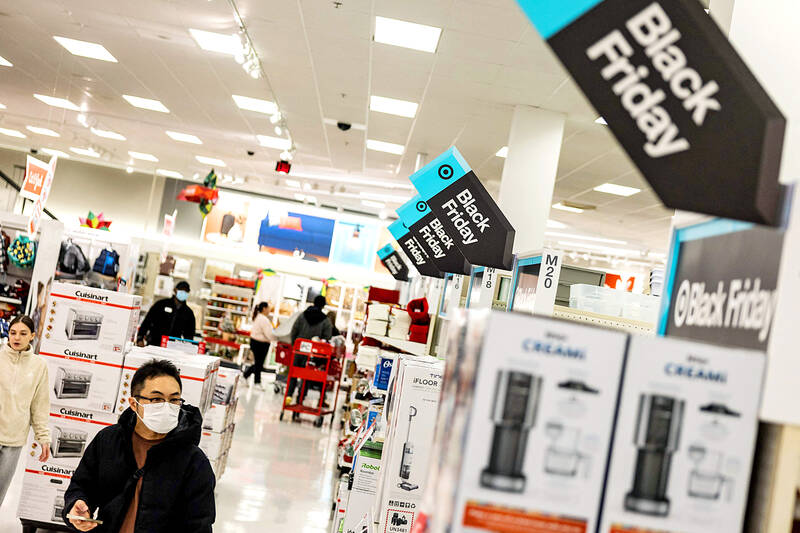US shoppers are coming out in force this holiday season, but the festiveness is being tempered by inflationary pressures that have abated but not completely faded.
After the sticker shock during the latter stages of the COVID-19 pandemic, a familiar frustration has settled in toward consumer prices that remain broadly elevated even if they have stopped rising rapidly.
Americans are “ready to open their wallets this holiday season,” said the Conference Board ahead of Black Friday — the day after Thanksgiving, which this year, falls on Nov. 28 — that traditionally sees US stores kick off the Christmas shopping season with steep discounts. “US consumers plan to spend more than last year, but inflation reduces how far their dollars can go.”

Photo: Samuel Corum, AFP
In this environment, nobody expects to pay the full price for items.
“Holiday shoppers are likely to increase their budgets this year versus last year but remain selective and are looking for discounts,” Morgan Stanley said in a note.
The investment bank’s survey found that 35 percent planned to spend more this holiday season. But nearly two-thirds would skip a purchase if an item is not adequately discounted, meaning a price cut of more than 20 percent.
“It’s gonna be a good year, but I don’t think that growth is going to be spectacular because consumers are still under pressure,” GlobalData managing director and retail analyst Neil Saunders said.
Inflation remains above the US Federal Reserve’s 2 percent long-term target, rising to 2.6 percent on an annual basis last month from 2.4 percent in September. But that’s significantly below the peak level of 9.1 percent in June 2022.
“There is still a perception among consumers that things are quite difficult,” Saunders said. “So people are being quite cautious and careful in their spending.”
How US president-elect Donald Trump’s looming presidency will affect inflation remains to be seen. Industry groups have warned that tariffs favored by the Republican could reignite pricing pressures.
The National Retail Federation (NRF) projected that a Trump tariff proposal floated during the campaign would dent US consumer budgets by as much as US$78 billion annually.
But while tough potential trade actions are already preoccupying Washington trade groups, tariffs are not on consumer radars for this shopping season, Saunders said.
One challenge this year will be the shortness of the season. Black Friday falls at the latest possible date on Nov. 29, shortening the stretch between Turkey Day and Christmas on Dec. 25.
But the impact of that dynamic on this year’s sales should not be overstated. Retailers in recent years have pulled the holiday shopping season ahead, with some vendors launching online “Black Friday” promotions as early as October.
Among the companies that have already begun discounts: the big-box chains Walmart Inc and Target Corp, electronics giant Best Buy Co and home-improvement retailer Home Depot Inc. Amazon.com Inc officially launched “Black Friday Week” on Thursday last week.
The NRF has projected holiday spending growth of between 2.5 and 3.5 percent in this season compared with the year-ago period, to as much as US$989 billion over the two-month period.
Economists with the trade group have pointed to an easing of gasoline prices as a supportive factor.
Online sales are projected to grow as much as nine percent this season, extending a long-term trend. Black Friday itself has become a big occasion for online shopping, along with “Cyber Monday” three days later.
“Over time, we’ve moved from a period where it was just Black Friday, and maybe a little of the weekend, to it being a period of discounting that starts very early,” Saunders said. “It’s seasonal discounts.”
There has been a diminishment of “doorbuster” sales that are known to draw hordes of waiting crowds, sometimes resulting in injury or worse. Instead, increasing numbers of consumers are spreading out their purchases or opting to click through Black Friday promotions at home.

Taiwan Semiconductor Manufacturing Co (TSMC, 台積電) yesterday said that its investment plan in Arizona is going according to schedule, following a local media report claiming that the company is planning to break ground on its third wafer fab in the US in June. In a statement, TSMC said it does not comment on market speculation, but that its investments in Arizona are proceeding well. TSMC is investing more than US$65 billion in Arizona to build three advanced wafer fabs. The first one has started production using the 4-nanometer (nm) process, while the second one would start mass production using the

‘SILVER LINING’: Although the news caused TSMC to fall on the local market, an analyst said that as tariffs are not set to go into effect until April, there is still time for negotiations US President Donald Trump on Tuesday said that he would likely impose tariffs on semiconductor, automobile and pharmaceutical imports of about 25 percent, with an announcement coming as soon as April 2 in a move that would represent a dramatic widening of the US leader’s trade war. “I probably will tell you that on April 2, but it’ll be in the neighborhood of 25 percent,” Trump told reporters at his Mar-a-Lago club when asked about his plan for auto tariffs. Asked about similar levies on pharmaceutical drugs and semiconductors, the president said that “it’ll be 25 percent and higher, and it’ll

When an apartment comes up for rent in Germany’s big cities, hundreds of prospective tenants often queue down the street to view it, but the acute shortage of affordable housing is getting scant attention ahead of today’s snap general election. “Housing is one of the main problems for people, but nobody talks about it, nobody takes it seriously,” said Andreas Ibel, president of Build Europe, an association representing housing developers. Migration and the sluggish economy top the list of voters’ concerns, but analysts say housing policy fails to break through as returns on investment take time to register, making the

CHIP BOOM: Revenue for the semiconductor industry is set to reach US$1 trillion by 2032, opening up opportunities for the chip pacakging and testing company, it said ASE Technology Holding Co (日月光投控), the world’s largest provider of outsourced semiconductor assembly and test (OSAT) services, yesterday launched a new advanced manufacturing facility in Penang, Malaysia, aiming to meet growing demand for emerging technologies such as generative artificial intelligence (AI) applications. The US$300 million facility is a critical step in expanding ASE’s global footprint, offering an alternative for customers from the US, Europe, Japan, South Korea and China to assemble and test chips outside of Taiwan amid efforts to diversify supply chains. The plant, the company’s fifth in Malaysia, is part of a strategic expansion plan that would more than triple